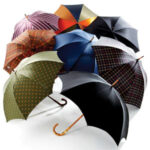Spring is nearly sprung upon us, and with the changing of the season comes rain. Rain water is not bad for our clothes — after all, we need to wash them on a regular basis — but because our clothes are often made from organic fibers, and these fibers retain moisture, it’s possible for them to develop mold and bacteria if they stay damp too long, giving them a distinct odor. Rain can also harbor pollutants, which impart another odor to our clothes.
The simple solution to these problems is investing in an umbrella. The word umbrella comes to us from the Latin word umbra, which means shade, so umbrella literally translates as “little shade.” The umbrella as we know it today has been with us for at least 2,000 years. The earliest record of a collapsible umbrella is from ancient China and was made for the carriage of Emperor Wang Mang. From then until the 18th century, umbrellas were a mark of nobility or aristocracy.
In 18th century Paris the image of the umbrella changed: they had become so common that rather than being a mark of nobility, it was a mark of someone who couldn’t afford their own carriage. In the early 1800s there were seven shops making umbrellas in Paris, but by 1848 there were over 350. Today, there are so many ideas for umbrellas, the U.S. Patent Office has a staff dedicated to handling only umbrella patents.
So with so much diversity in the market for umbrellas, which one is right for you?
Collapsible

Collapsible umbrellas are the most common. They have a shaft that telescopes so that, fully retracted, the umbrella can be carried in a bag or pocket. Because they are often made with portability in mind, they tend to be made from lighter materials, such as aluminum. That said, the collapsible umbrella is also more prone to breaking since it’s made from more parts of less durability.
Full-length

The full-length umbrella has a solid shaft that is traditionally made out of wood but today is often made out of steel or fiberglass. The canopy is typically larger than a collapsible umbrella’s and provides more coverage. The trade-off is in portability – there’s no way this umbrella will fit in a bag. Instead, these umbrellas need to be carried, and are just as much a fashion accessory as they are utilitarian.
Style
Now that we know which umbrella we need, it’s time to think about style. The first major style consideration is the canopy. The safest bet is to go all black because it will coordinate with anything we wear, but it’s possible to find a canopy in any pattern or color we choose — from simple stripes to a more complex plaid. The next most important thing to think about is the handle. The traditional handle is wooden and has a curve to it but it’s possible to find anything from a skull, duck head, or sword hilt. I recommend sticking with something traditional since it will work with any outfit and will always look good.
Like any fashion accessory, we can pay as little – or as much – as we want. At the low end of the spectrum are the $10 umbrellas sold at Target that will last us one season. At the other end of the spectrum are hand-made bespoke umbrellas made by Francesco Maglia which cost over $500. We probably don’t need the $500 umbrella, but we get what we pay for and it never hurts to have a sturdy umbrella on hand to class up an ensemble. For less than $100, Brooks Brothers has quality umbrellas that will last for years and stay in style for just as long.

 |
 |
 |
 |
 |
 |
Resources used for this article:
https://en.wikipedia.org/wiki/Umbrella
http://www.artofmanliness.com/2009/06/12/the-gentlemans-guide-to-umbrellas/
http://www.newyorker.com/magazine/2008/02/11/thinking-in-the-rain




